The birds in the Distinguished Birds category represent nearly every continent and range in size from the diminutive but colorful songbird, the Red Siskin of Venezuela, to the impressive Red-tailed Hawk found throughout North America.
To inquire about Name-A-Bird opportunities, please contact Ted Bartlett at [email protected] or 412-258-9433.
Naming Agreement and Understanding: Following approval of the requested name, the name will be registered in the official ZIMS registry and shall remain the official name for the entirety of the life of the bird at the National Aviary. Due to the nature of working with live animals, specific lifespans of animals cannot be guaranteed. Because the National Aviary is part of the Association of Zoos and Aquariums (AZA) Species Survival Plan® program, a coordinated conservation effort to save animals from extinction, there is no guarantee that the bird will remain at the National Aviary for its full lifespan, and may be subject to relocation at any time to another AZA institution or to be released to the wild.
Perching Birds & Songbirds
Among the most varied group, perching birds and songbirds come in all shapes and sizes, from the small, sparrow-sized Red Bishop to the large, crow-sized Capuchinbird, and all colors, too, from the slate gray of the elegant Scissor-tailed Flycatcher to the bright hues of the Red Siskin. Perching birds and songbirds are vulnerable around the world to the effects of climate change and loss of habitat.
The bright yellow head of the Golden-crested Myna (Ampeliceps coronatus) stands out in the lowland evergreen forests it inhabits in eastern India to Thailand. These sleek birds forage in small groups in the tree canopy, eating fruit and insects. While this species is common throughout most of its range, it is vulnerable to deforestation.
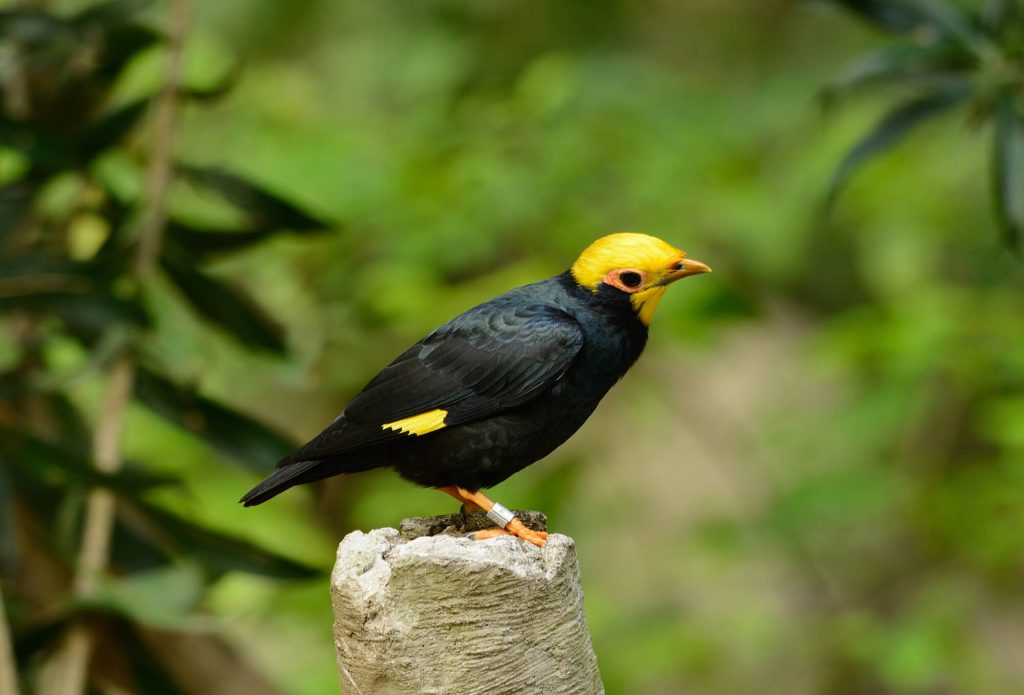
- Golden-crested Myna (Ampeliceps coronatus)
- Type of Bird: Perching Bird
- Native Range: Eastern India south to Thailand
- At the Aviary: Resides in the Tropical Rainforest
- Lifespan: 15-20 years
- Conservation Status: Least Concern
- Available for Naming: 1 male
- Naming Rights: $2,500
The male Red-legged Honeycreeper (Cyanerpes cyaneus) is a brilliant blue with glossy black accents, and the female is a vibrant green. Found throughout southern Mexico south to Brazil, these small songbirds live in the tropical lowlands in woodland areas. Populations of Red-legged Honeycreeper remain common and even abundant.
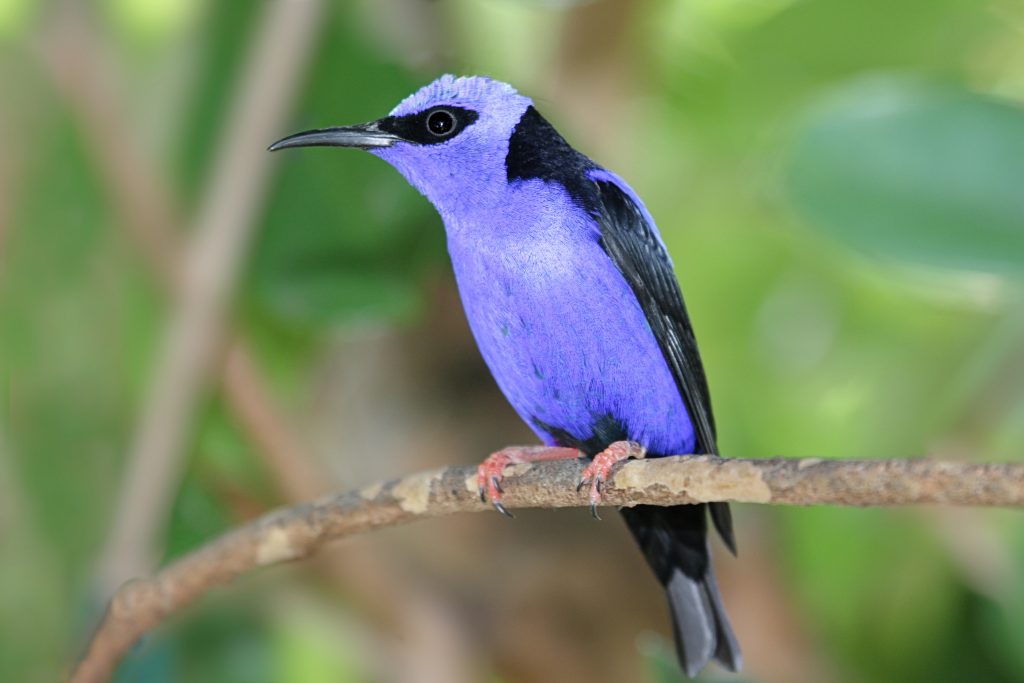
- Red-legged Honeycreeper (Cyanerpes cyaneus)
- Type of Bird: Perching Bird
- Native Range: Mexico, Brazil, Cuba
- At the Aviary: Resides in the Grasslands and Tropical Rainforest
- Lifespan: 10-15 years
- Conservation Status: Least Concern
- Available for Naming: 1 male
- Naming Rights: $2,500
The Scissor-tailed Flycatcher (Tyrannus forficatus) is common throughout its range in the south-central U.S. and Central America, where it can found perched on shrubs, tree, and fences in grassland and shrubland areas. True to its name, it eats by catching insects on the wing, swooping gracefully through the air. Scissor-tailed Flycatchers are abundant and their populations are stable.
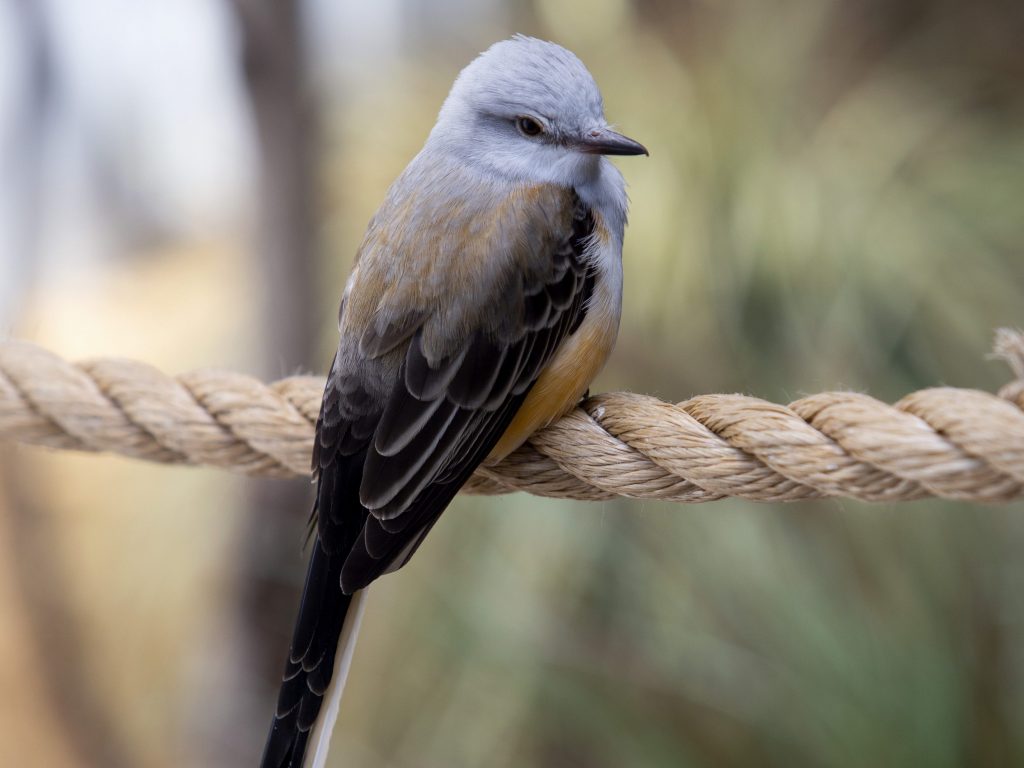
- Scissor-tailed Flycatcher (Tyrannus forficatus)
- Type of Bird: Perching Bird
- Native Range: South-central U.S., Mexico, and Central America
- At the Aviary: Resides in the Grasslands
- Lifespan: 10-15 years
- Conservation Status: Least Concern
- Available for Naming: 2 females
- Naming Rights: $2,500
The Superb Starling (Lamprotornis superbus) is a small starling with distinctive glossy blue, black, and orange coloring that appears almost metallic. These beautiful birds are very social, gathering in flocks of dozens of individuals in forests and woodlands throughout their range in eastern Africa. Superb Starlings are not globally threatened, and are widespread and abundant.
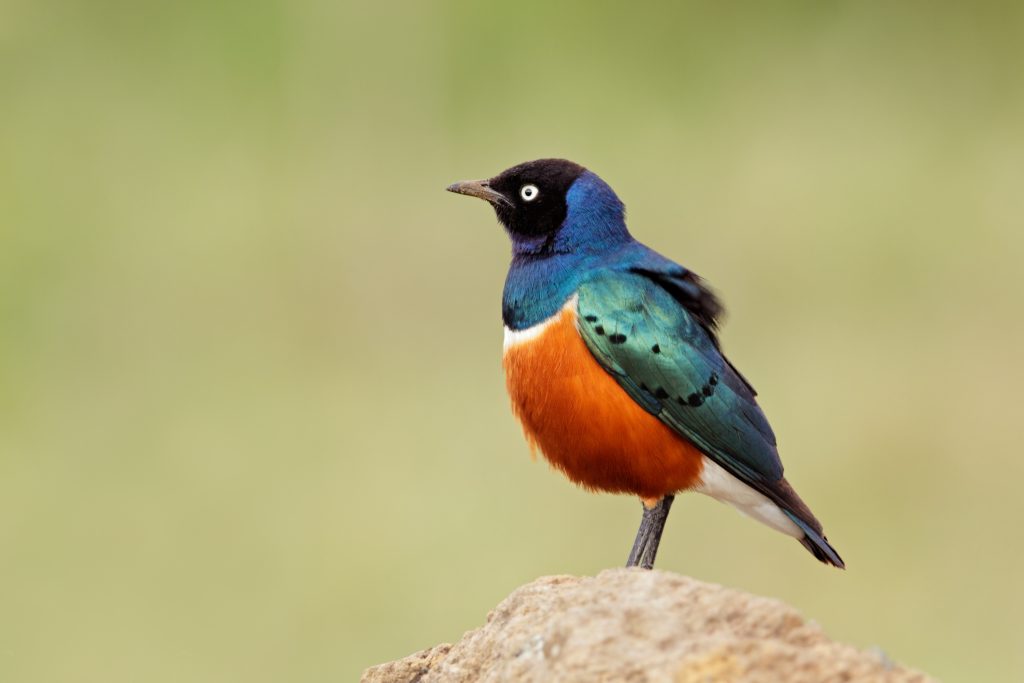
- Superb Starling(Lamprotornis superbus)
- Type of Bird: Perching Bird
- Native Range: Eastern Africa
- At the Aviary: Resides in the Tropical Rainforest
- Lifespan: 10-15 years
- Conservation Status: Least Concern
- Available for Naming: 4 females
- Naming Rights: $2,500
The Venezuelan Troupial (Icterus icterus) is the national bird of Venezuela. The bright orange plumage of the Troupial stands out in the acacia woodlands and savannas it inhabits throughout Venezuela and Colombia. They are sometimes known as “bugle birds” because of their piercing and melodic voices. Troupial populations are stable, and the bird is common throughout its range.
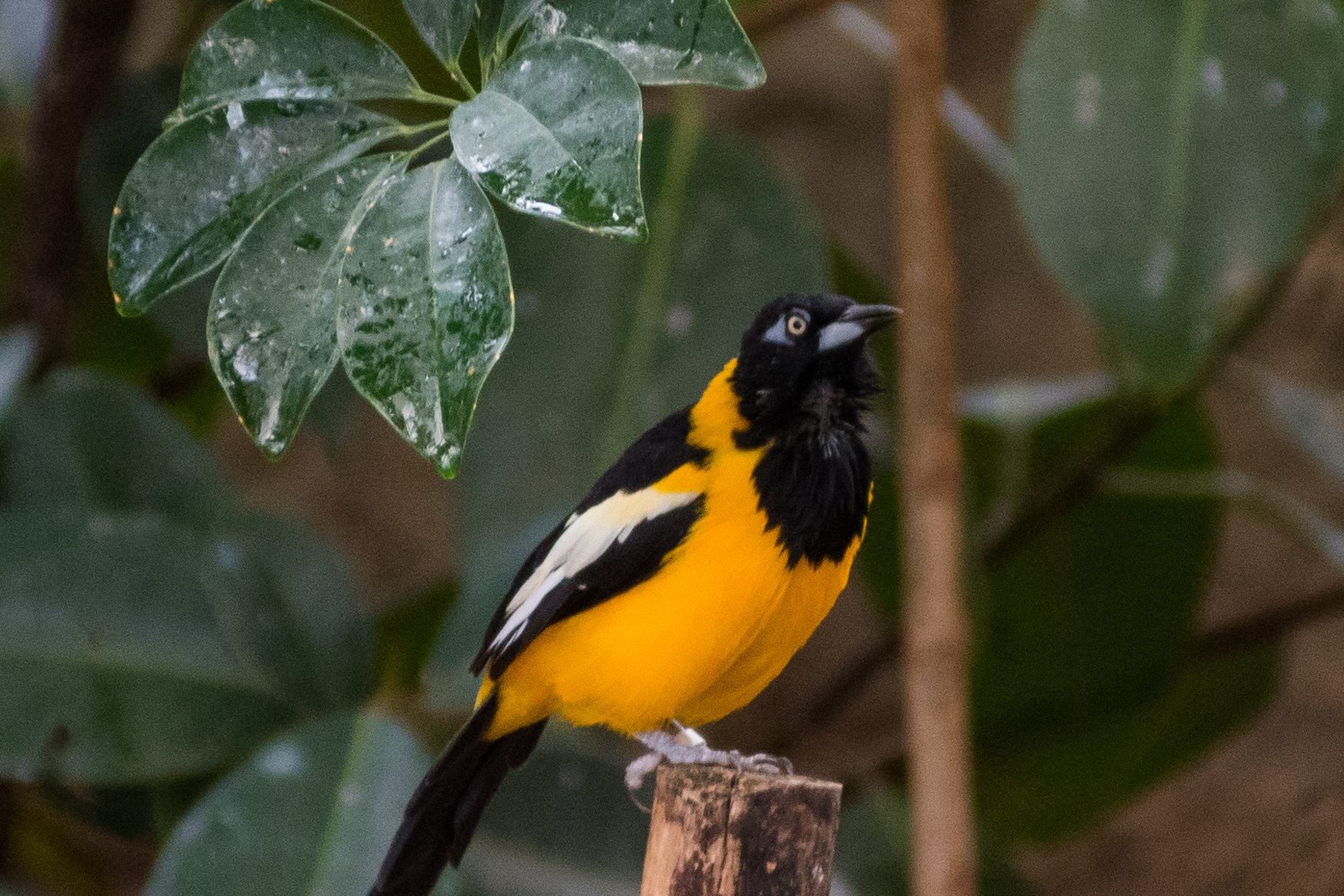
- Venezuelan Troupial (Icterus icterus)
- Type of Bird: Perching Bird
- Native Range: Venezuela and Colombia
- At the Aviary: Resides in the Tropical Rainforest/Canary’s Call
- Lifespan: 10-15 years
- Conservation Status: Least Concern
- Available for Naming: 3 males, 2 females
- Naming Rights: $2,500
The White-throated Bee-eater (Merops albicollis) is a colorful bird found in savannah woodlands and desert steppes throughout central Africa. Its plumage is eye-catching, with vibrant blues, greens, and crimson, and it has a long, thin tail. The White-throated Bee-eater feeds during continuous flights, grabbing honeybees, beetles, and other insects on the wing. This species is common throughout its range and is considered a species of Least Concern.
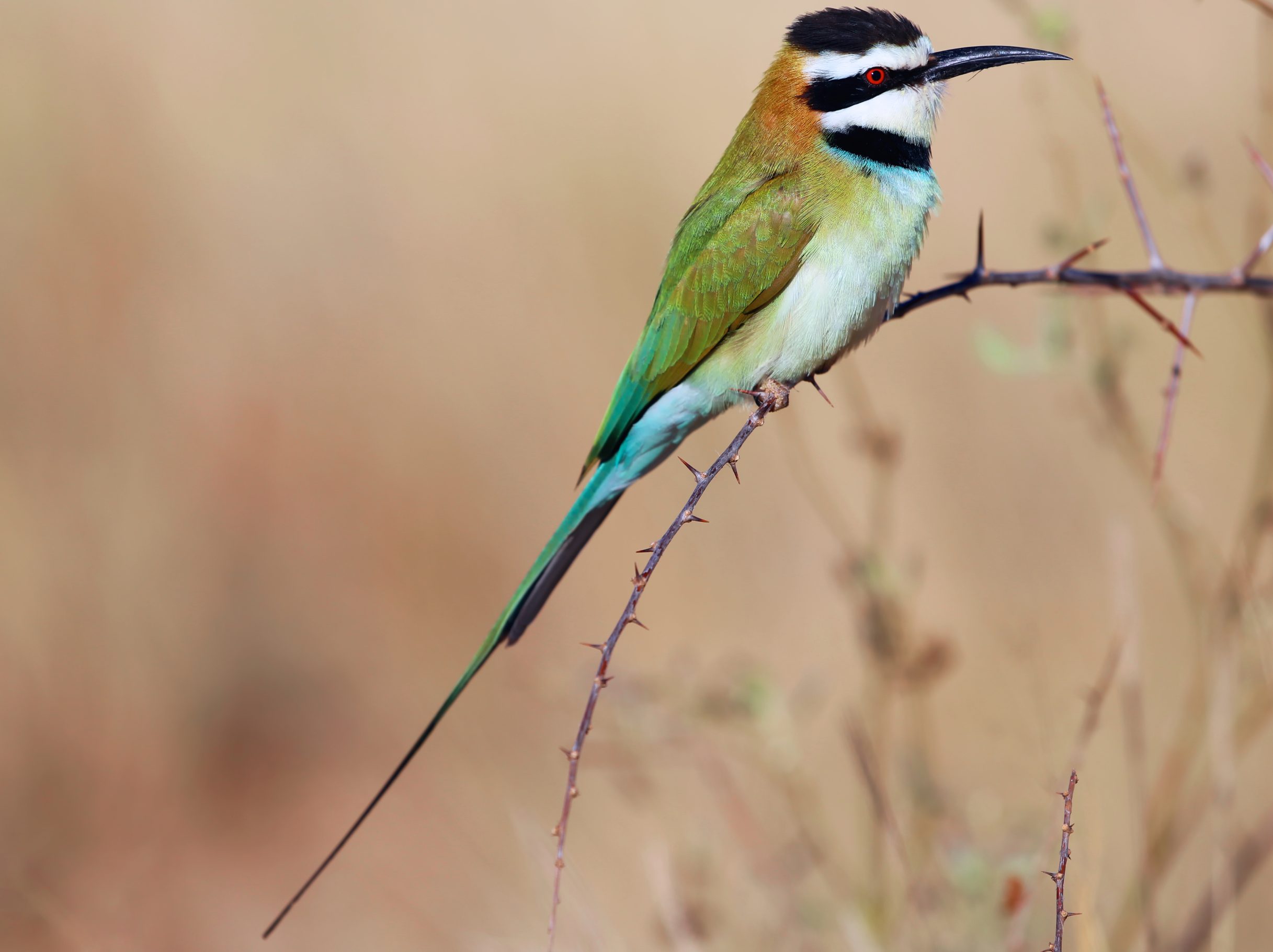
- White-throated Bee-eater (Merops albicollis)
- Type of Bird: Perching Bird
- Native Range: West Africa and from Mauritania to Kenya
- At the Aviary: Resides in the Grasslands
- Lifespan: 10 years
- Conservation Status: Least Concern
- Available for Naming: 1 male
- Naming Rights: $2,500
The Red Siskin (Spinus cucullatus) is an Endangered songbird found in scattered locations in northern South America. It has gorgeous, vibrant scarlet plumage, which made it desirable for hybridizing with domesticated canaries. This once abundant bird inspired literature, music, and even appears on currency in Venezuela. The National Aviary is working to bring this species back from the brink of extinction.
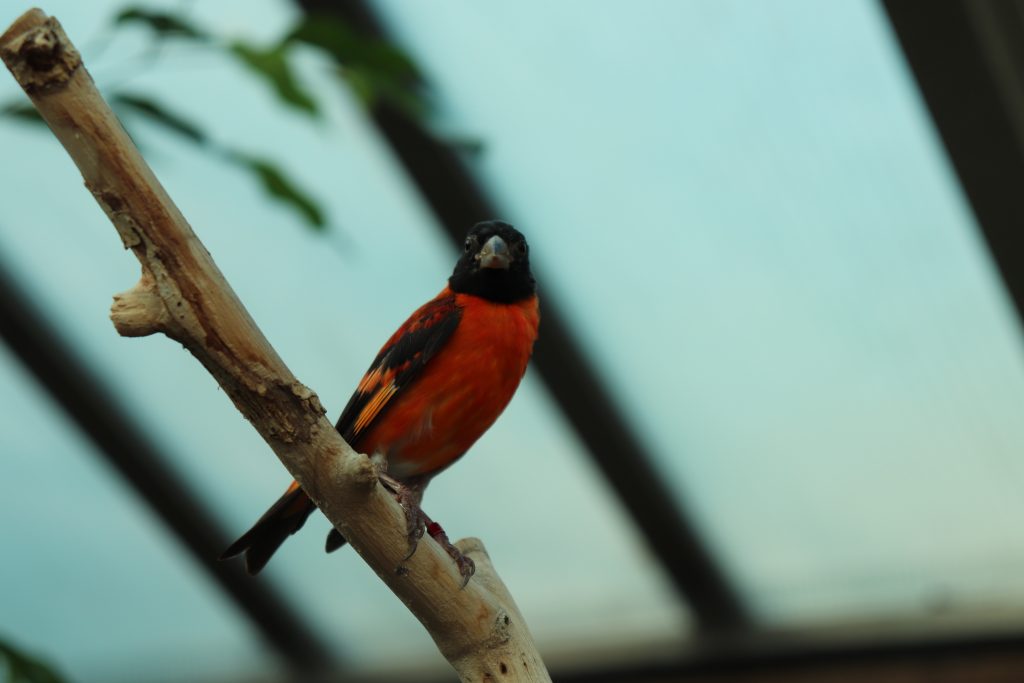
- Red Siskin (Spinus cucullatus)
- Type of Bird: Perching Bird
- Native Range: Isolated pockets of northern Venezuela
- At the Aviary: Resides in the Grasslands
- Lifespan: 4-8 years
- Conservation Status: Endangered
- Available for Naming: 1 male, 2 females
- Naming Rights: $2,500
Waterbirds
Waterbirds can include birds as different as the tiny North American Ruddy Duck, the long and lanky Javan Pond Heron, and the unusual looking shorebird, the Masked Lapwing. Waterbirds around the world are vulnerable to habitat loss, environmental pollution, and the effects of climate change.
The Javan Pond Heron (Ardeola speciose) inhabits freshwater swamps and ponds in Java and Borneo. This handsome heron has cinnamon-colored plumage on its head and neck that fade into gray and white. Populations of the Javan Pond Heron are stable, and may even be increasing.
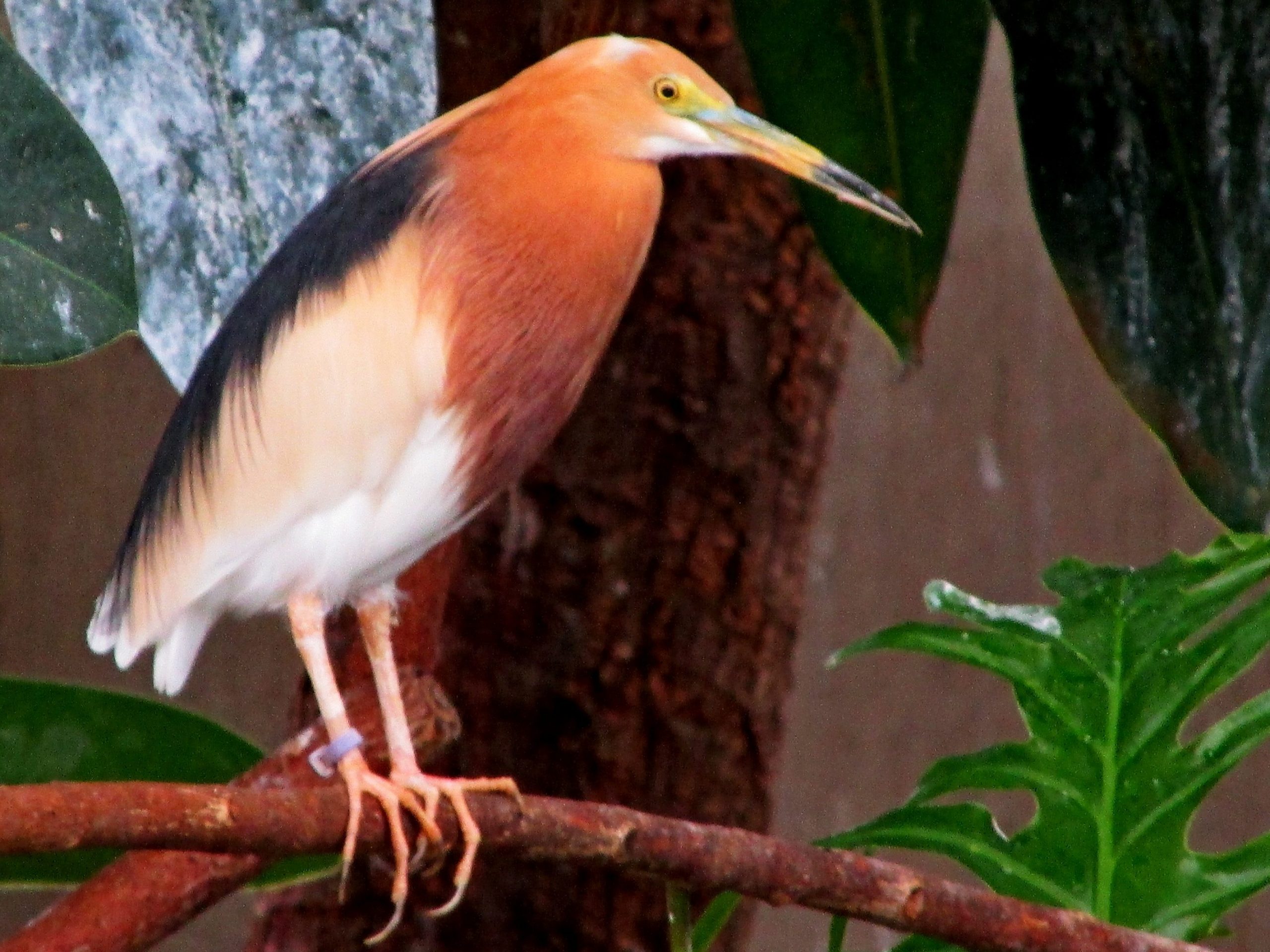
- Javan Pond Heron (Ardeola speciose)
- Type of Bird: Waterbird
- Native Range: Java, Borneo, and Philippines
- At the Aviary: Resides Behind the Scenes
- Lifespan: 15-20 years
- Conservation Status: Least Concern
- Available for Naming: 2 males
- Naming Rights: $2,500
The Sunbittern (Eurypyga helias) is a long and lanky heron-like waterbird found in parts of Central and South America. At first, these birds may appear cryptic, easily blending in with the surrounding forested areas near the streams and pools they inhabit. But, when they spread their wings, they reveal a beautiful sunburst pattern. Populations of Sunbitterns remain stable.
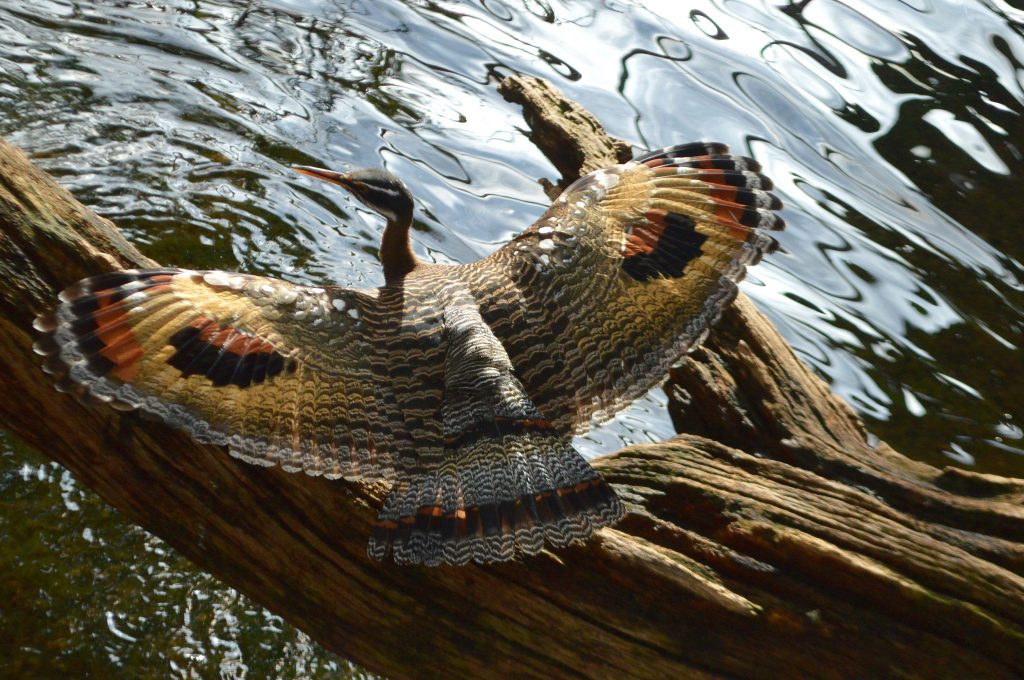
- Sunbittern (Eurypyga helias)
- Type of Bird: Waterbird
- Native Range: Central and South America
- At the Aviary: Resides Behind the Scenes
- Lifespan: 15-20 years
- Conservation Status: Least Concern
- Available for Naming: 1 male, 1 female
- Naming Rights: $2,500
The North American Ruddy Duck (Oxyura jamaicensis) is a petite duck, recognizable by its short tail that sticks straight up out of the water. Males have striking blue bills and perform elaborate and even comical courtship displays. While populations of Ruddy Ducks are stable, they rely on marshes, ponds, and shallow lakes, and remain vulnerable to habitat degradation and loss.
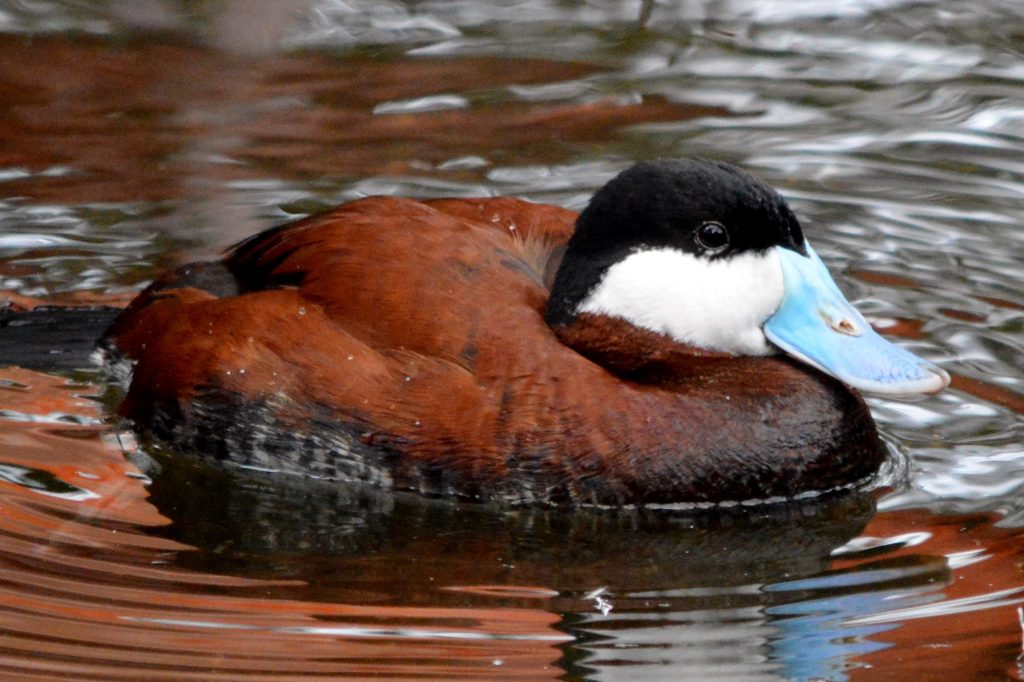
- North American Ruddy Duck (Oxyura jamaicensis)
- Type of Bird: Waterbird
- Native Range: Widespread throughout North America and on the western side of South America
- At the Aviary: Resides in the Tropical Rainforest
- Lifespan: 15-20 years
- Conservation Status: Least Concern
- Available for Naming: 1 male
- Naming Rights: $2,500
The Roseate Spoonbill (Platalea ajaja) is a recognizable bird, with a long, rounded bill and feathers that are a deep pink hue. While there are six spoonbill species worldwide, the Roseate Spoonbill is the only one in the New World. It inhabits shallow aquatic habitats like marshes, swamps, and lakes. Populations have recovered after overhunting for its feathers decimated Roseate Spoonbill populations. Habitat loss and degradation are threats for this species.
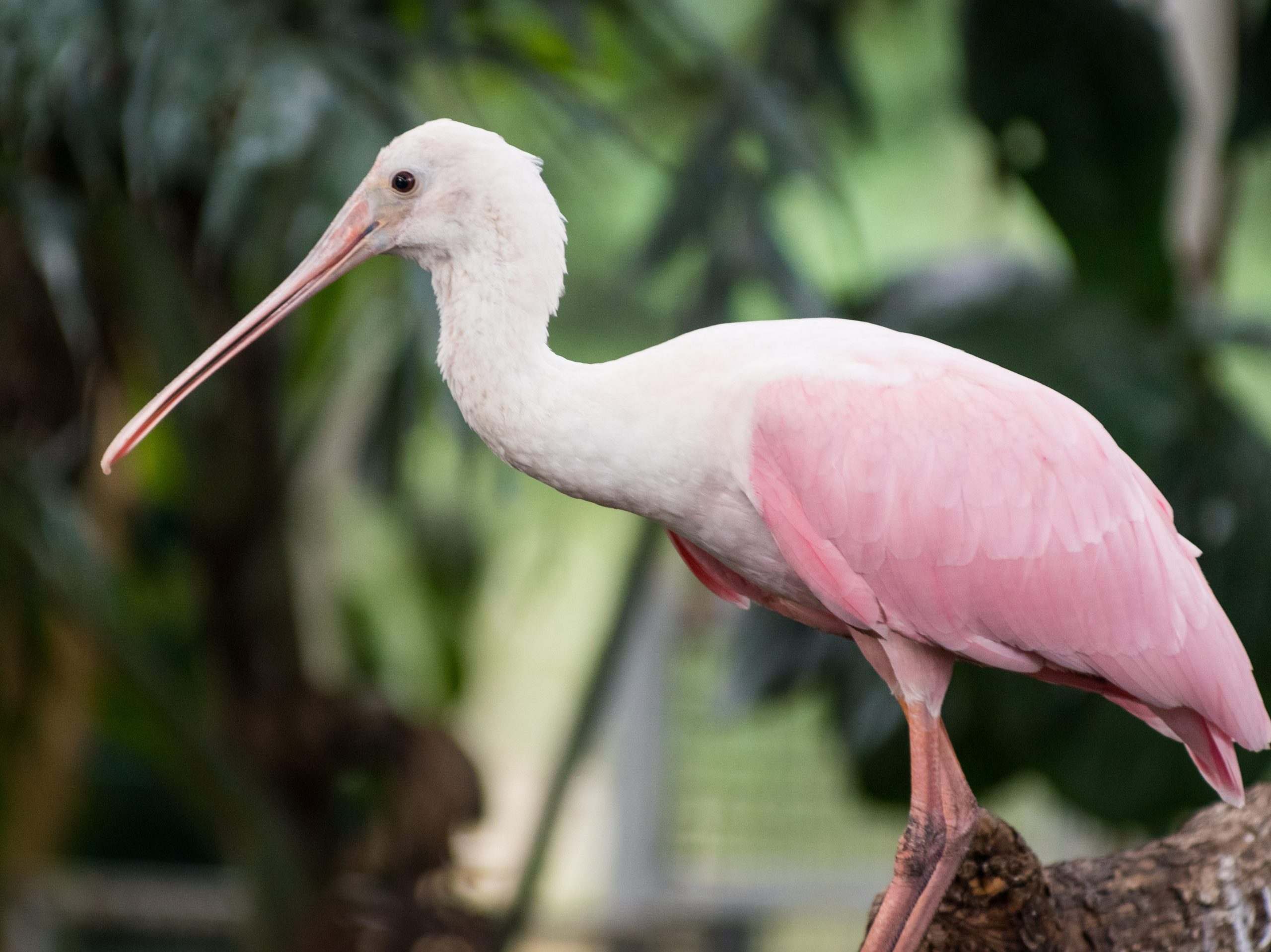
- Roseate Spoonbill (Platalea ajaja)
- Type of Bird: Waterbird
- Native Range: Coastal areas in the southern U.S. and Central America, and throughout much of South America
- At the Aviary: Resides Behind the Scenes
- Lifespan: 15-20 years
- Conservation Status: Least Concern
- Available for Naming: 2 males
- Naming Rights: $2,500
The Inca Tern (Larosterna inca) is a dashing bird found along the Pacific coast from Peru to Chile. These graceful birds are highly social, nesting in colonies of several thousand birds. They are perhaps best known for the mustache-like feathers found on both males and females. Inca Terns are in decline and are considered Near Threatened, and are vulnerable to introduced predators.
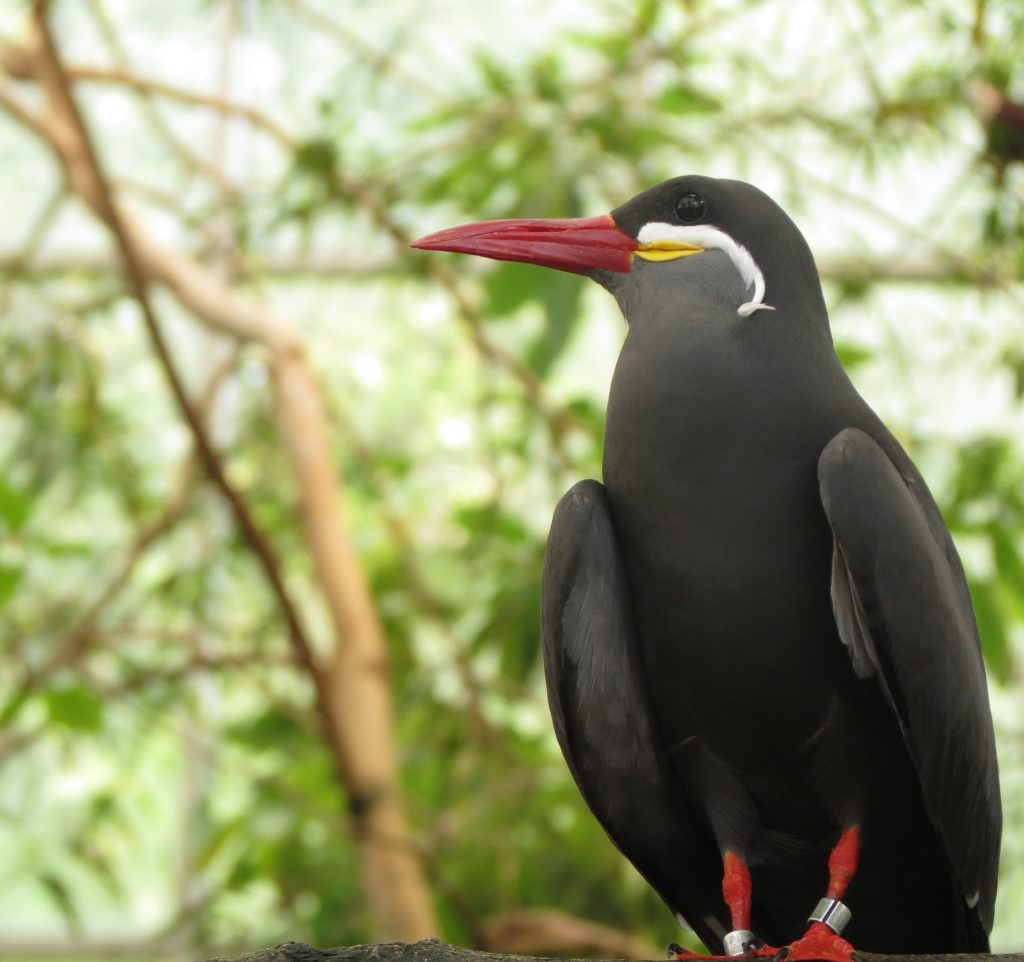
- Inca Tern (Larosterna inca)
- Type of Bird: Waterbird
- Native Range: Pacific coast, from Peru to Chile
- At the Aviary: Resides Behind the Scenes
- Lifespan: 10-15 years
- Conservation Status: Near Threatened
- Available for Naming: 3 males, 1 female
- Naming Rights: $2,500
The Scarlet Ibis (Eudocimus ruber) is an eye-catching waterbird found along the coasts of northern South America, from Ecuador to Brazil. This striking bird gets its crimson color from the crustaceans it eats as it forages in mangrove swamps, marshes, and lagoons. Scarlet Ibises are social birds and often flock with other species, including herons and spoonbills. While not globally threatened, habitat loss and pesticide use are concerns.
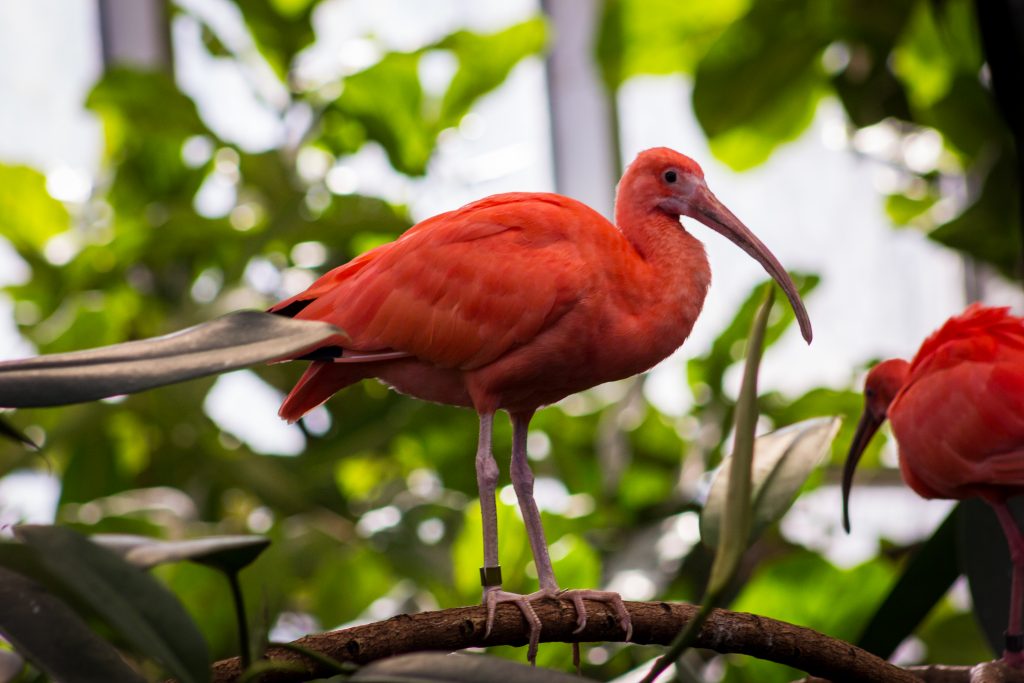
- Scarlet Ibis (Eudocimus ruber)
- Type of Bird: Waterbird
- Native Range: Coasts of northern South America
- At the Aviary: Resides Behind the Scenes
- Lifespan: 10-15 years
- Conservation Status: Least Concern
- Available for Naming: 3 females, 1 sex unknown
- Naming Rights: $2,500
The Marbled Teal (Marmaronetta angustirosris) is a small duck with beautiful, subtle brown and gray plumage. This species is found throughout the Mediterranean basin and throughout the Middle East. They prefer shallow freshwater and brackish ponds with densely vegetated shorelines, where they can gather in large groups of up to thousands of birds. Marbled Teals are Vulnerable. Habitat fragmentation, hunting, and habitat destruction are threats for this species.
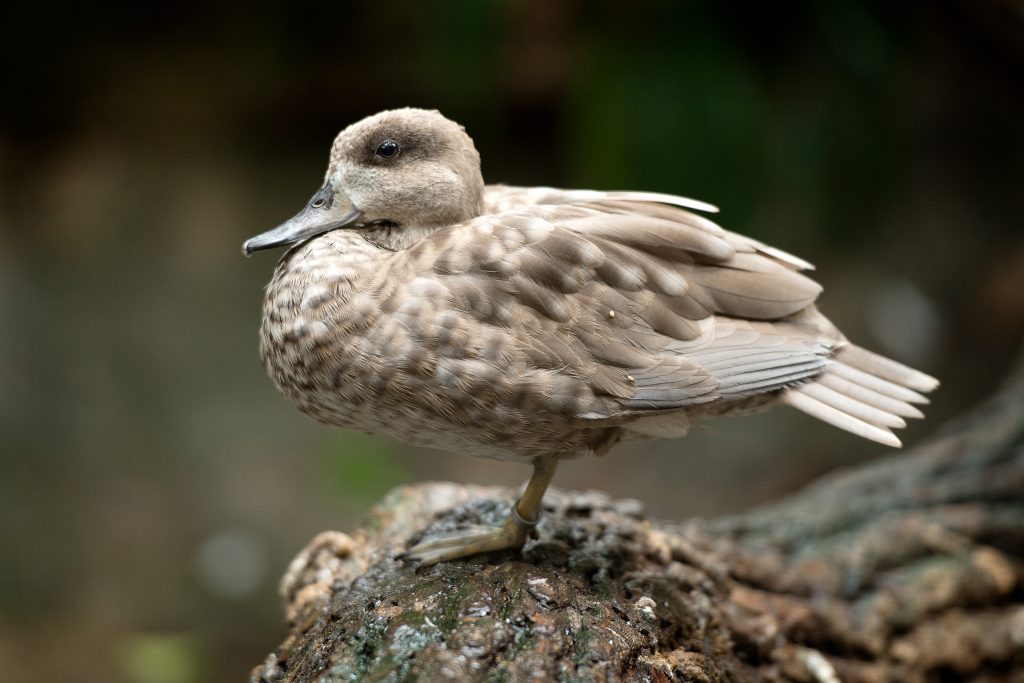
- Marbled Teal (Marmaronetta angustirosris)
- Type of Bird: Waterbird
- Native Range: Mediterranean basin, Middle East
- At the Aviary: Resides in the Tropical Rainforest
- Lifespan: 20-30 years
- Conservation Status: Vulnerable
- Available for Naming: 5 males
- Naming Rights: $2,500
The Bufflehead (Bucephala albeola) is a small diving duck found throughout North America, notable for its large head and their bobbing, buoyant swimming style. Unlike most ducks, Buffleheads are monogamous, and they nest in tree cavities excavated by woodpeckers. Bufflehead populations are stable, but water contamination and habitat degradation remain threats for this and other waterfowl.
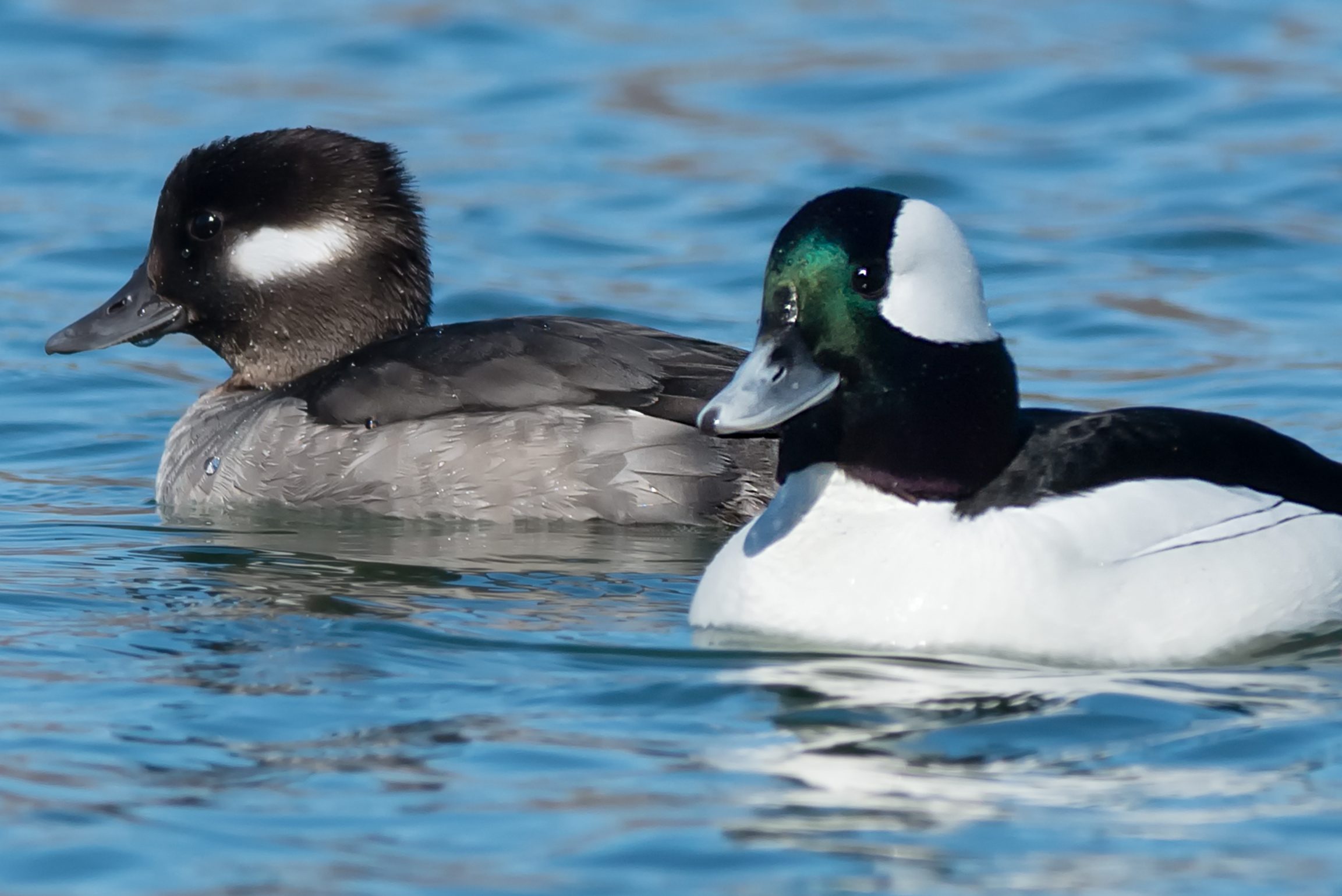
- Bufflehead (Bucephala albeola)
- Type of Bird: Waterbird
- Native Range: North America
- At the Aviary: Resides in the Tropical Rainforest
- Lifespan: 10-15 years
- Conservation Status: Least Concern
- Available for Naming: 2 males, 2 females
- Naming Rights: $2,500
The Boat-billed Heron (Cochlearius cochlearius) is a medium-sized heron with big brown eyes and a huge bill that resembles an overturned boat. This species is most active at night, when it forages along the edges of lakes and rivers in mangroves and freshwater swamps throughout Central and South America.
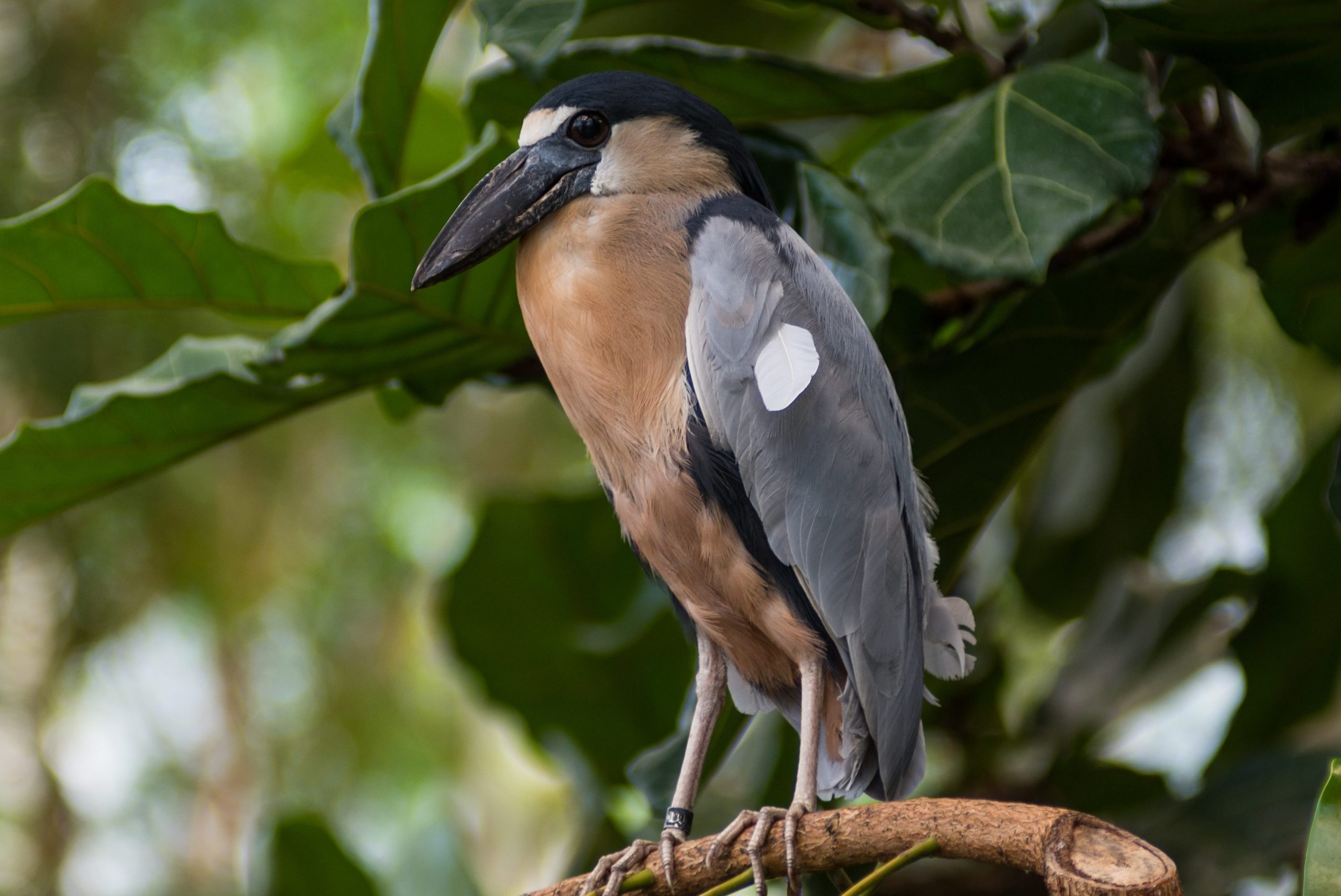
- Boat-billed Heron (Cochlearius cochlearius)
- Type of Bird: Waterbird
- Native Range: Central and South America
- At the Aviary: Resides Behind the Scenes
- Lifespan: 10-15 years
- Conservation Status: Least Concern
- Available for Naming: 1 male, 2 females
- Naming Rights: $2,500
The African Pygmy-goose (Nettapus auritus) is found in swamps, marshes, and other wetland habitats in Sub-Saharan Africa and Madagascar. The smallest waterfowl species in the world, African Pygmy-geese are actually dabbling ducks, not geese! This species is widespread and common, but some populations are declining as a result of hunting, invasive plant species, and water quality issues.
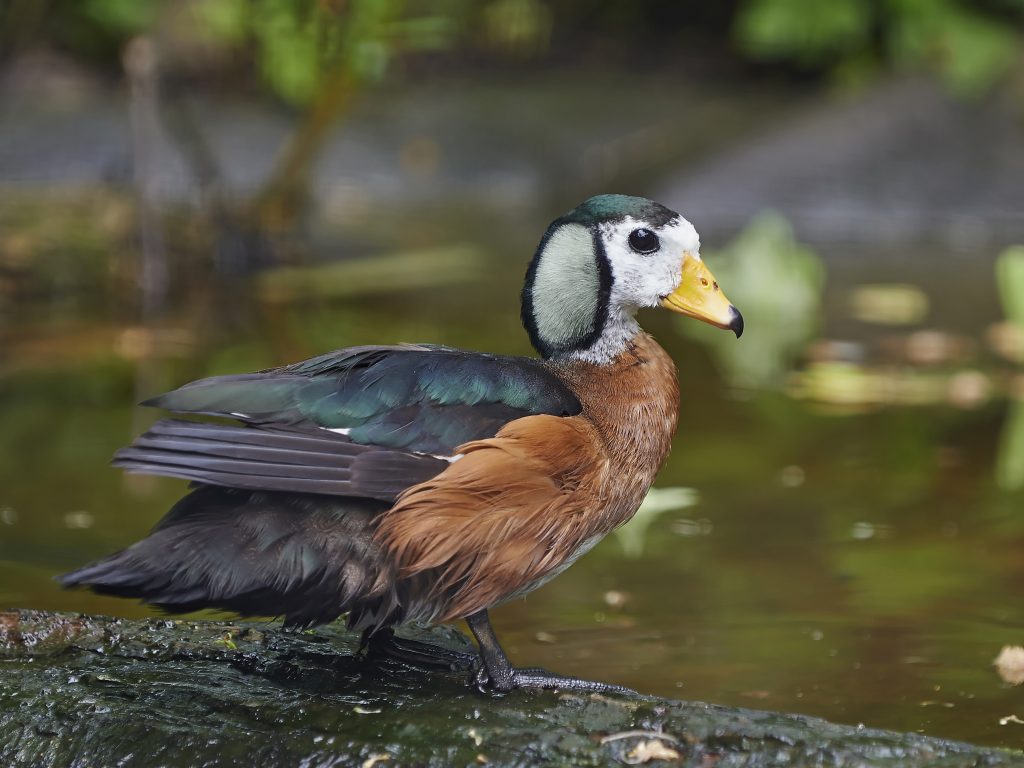
- African Pygmy-goose (Nettapus auritus)
- Type of Bird: Waterbird
- Native Range: Sub-Saharan Africa and Madagascar
- At the Aviary: Resides in the Tropical Rainforest
- Lifespan: 10-15 years
- Conservation Status: Least Concern
- Available for Naming: 1 female
- Naming Rights: $2,500
Doves & Pigeons
Known for their soft cooing calls, doves and pigeons are not often thought of as showy birds, but some truly stand out, like the Victoria Crowned Pigeon with its elaborate crown, or the eye-catching Mariana Fruit-Dove. Many dove and pigeon species are threatened by habitat loss and climate change.
The Luzon Bleeding-heart Dove (Gallicolumba luzonica) is a striking bird found in the Philippines. Like many doves, this species is shy and not commonly seen, preferring to stay deep in forested areas. Their call is a deep, mournful coo. This species is not globally threatened, but habitat destruction and hunting are threats.
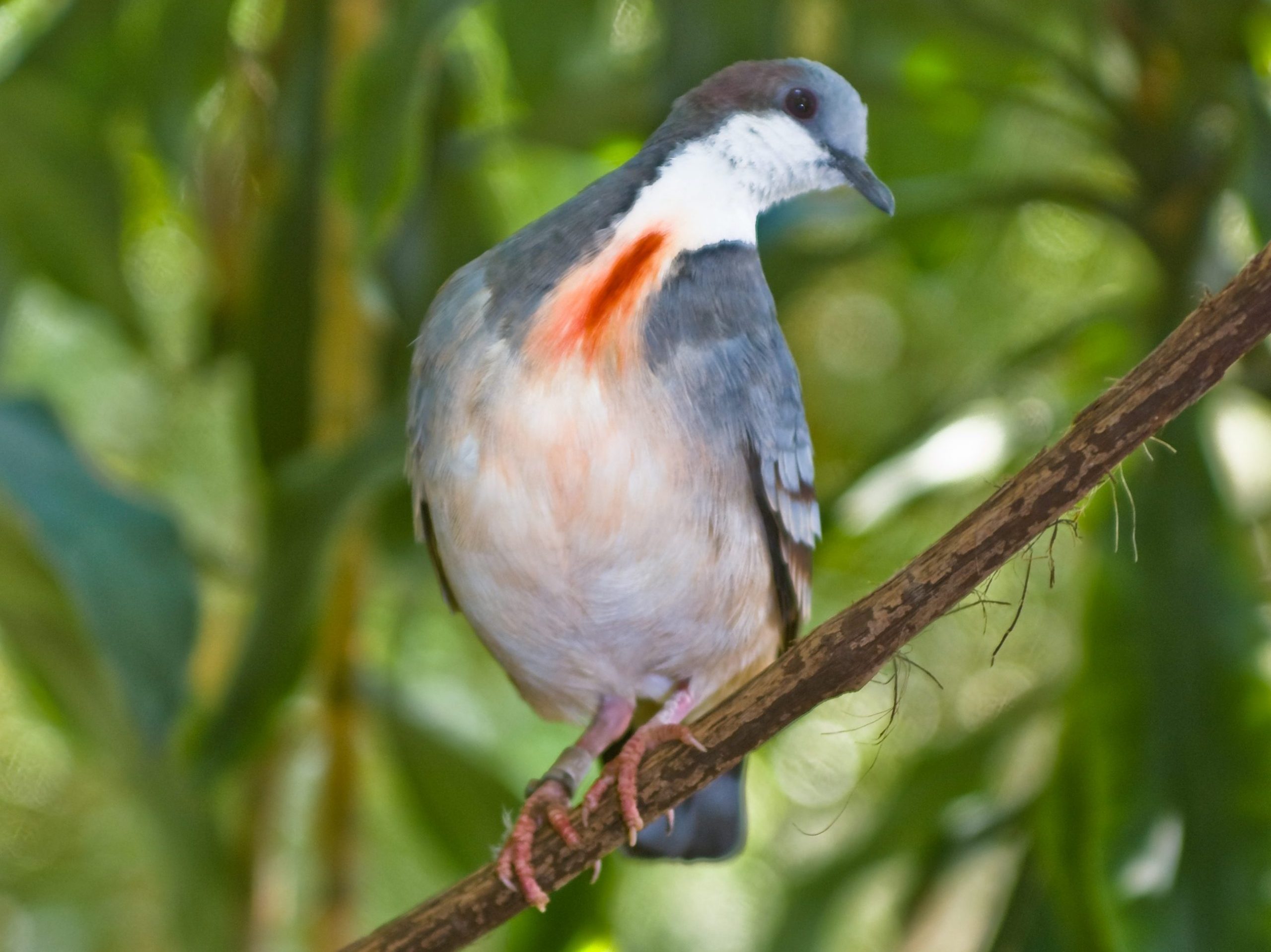
- Luzon Bleeding-heart Dove (Gallicolumba luzonica)
- Type of Bird: Dove
- Native Range: Philippines
- At the Aviary: Resides in Canary’s Call
- Lifespan: 10-15 years
- Conservation Status: Least Concern
- Available for Naming: 1 male, 1 female
- Naming Rights: $2,500
The Mariana Fruit-Dove (Ptilinopus roseicapilla) has gorgeous plumage of emerald greens, reds, and purples. It favors forested habitats in the Northern Mariana Islands. This species, like other Mariana Islands species, is considered Endangered due to the accidental introduction of an invasive species.
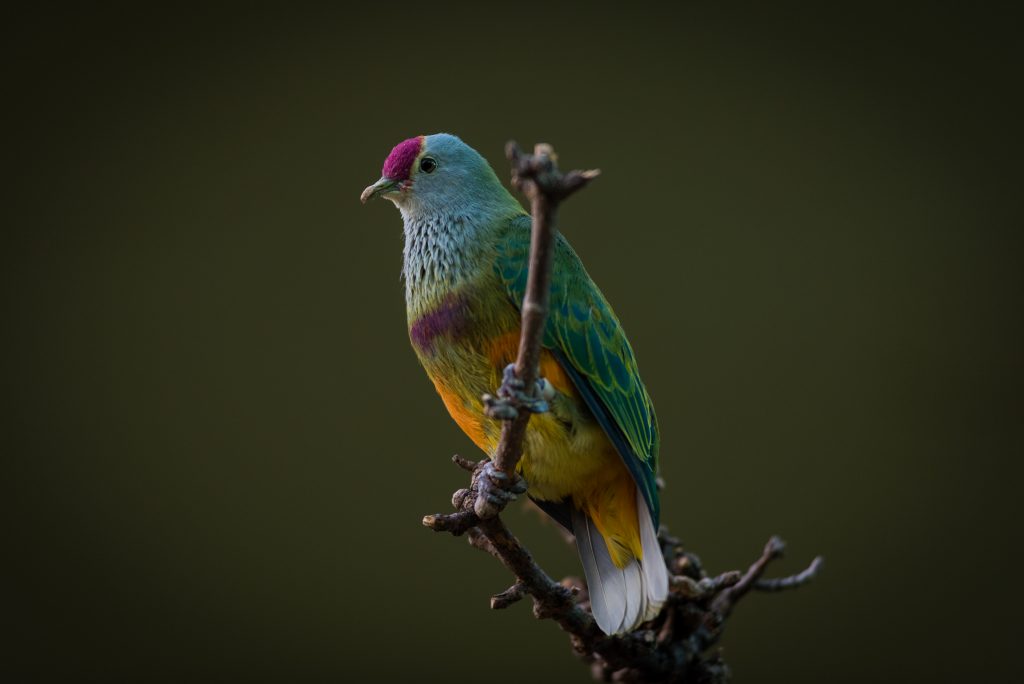
- Mariana Fruit-Dove (Ptilinopus roseicapilla)
- Type of Bird: Dove
- Native Range: Northern Mariana Islands, formerly Guam
- At the Aviary: Resides in the Tropical Rainforest and Behind the Scenes
- Lifespan: 10-15 years
- Conservation Status: Least Concern
- Available for Naming: 1 male, 1 female
- Naming Rights: $2,500
The Black-naped Fruit Dove (Ptilinopus melanospilus) is a colorful and eye-catching species found in the forests of Indonesia, Malaysia, and the Philippines. Males of this species are a rainbow of colors against an emerald green, while females are entirely green. It is thought that this species might be nomadic, capable of flying long distances over open sea from island to island.
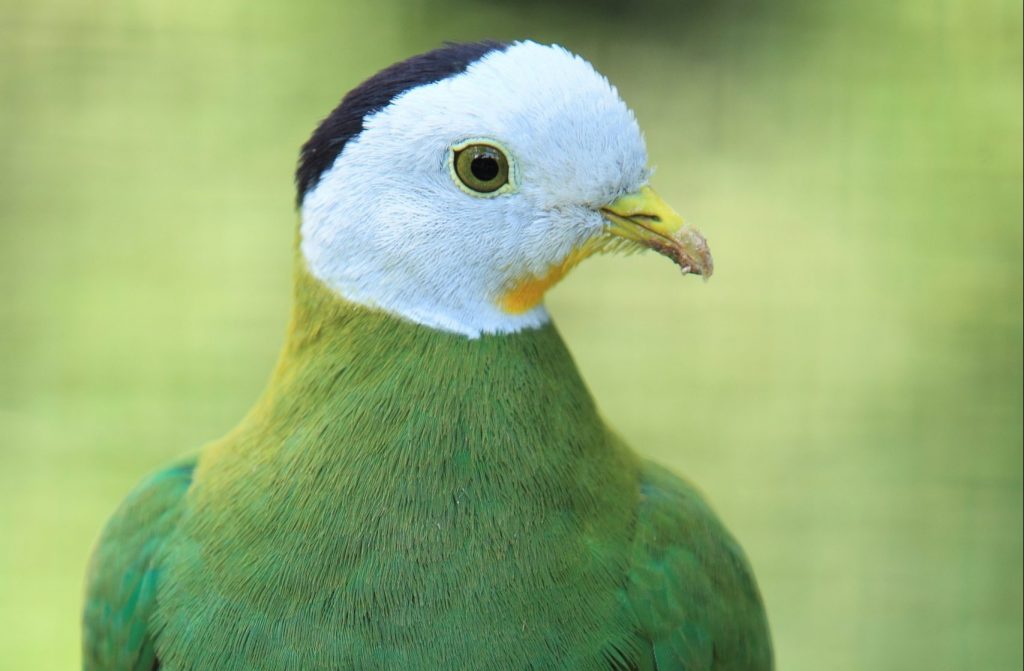
- Black-naped Fruit Dove(Ptilinopus melanospilus)
- Type of Bird: Doves and Pigeons
- Native Range: Indonesia, Malaysia, Philippines
- At the Aviary: Resides in the Andean Mountain habitat in Canary’s Call
- Lifespan: 10-15 years
- Conservation Status: Least Concern
- Available for Naming: 1 male
- Naming Rights: $2,500
Raptors
Raptors are impressive birds of prey, with powerful talons and beaks—adaptations that make them skillful hunters. Some raptors are familiar sights, like the ubiquitous Red-tailed Hawk, while others, like the Eastern Screech-Owl, are less conspicuous. Raptors around the world face threats to their survival, including habitat loss, poisoning, and collisions with the built environment.
The Red-tailed Hawk (Buteo jamaicensis) is a common sight throughout the U.S., Canada, and Mexico. This species is highly adaptable and can be found in habitats as varied as cloud forests in tropical regions and urban land. Red-tailed Hawk populations are stable, and may even be increasing in some areas, but they are susceptible to lead poisoning from eating animals shot with lead bullets, and from collisions with the built environment.
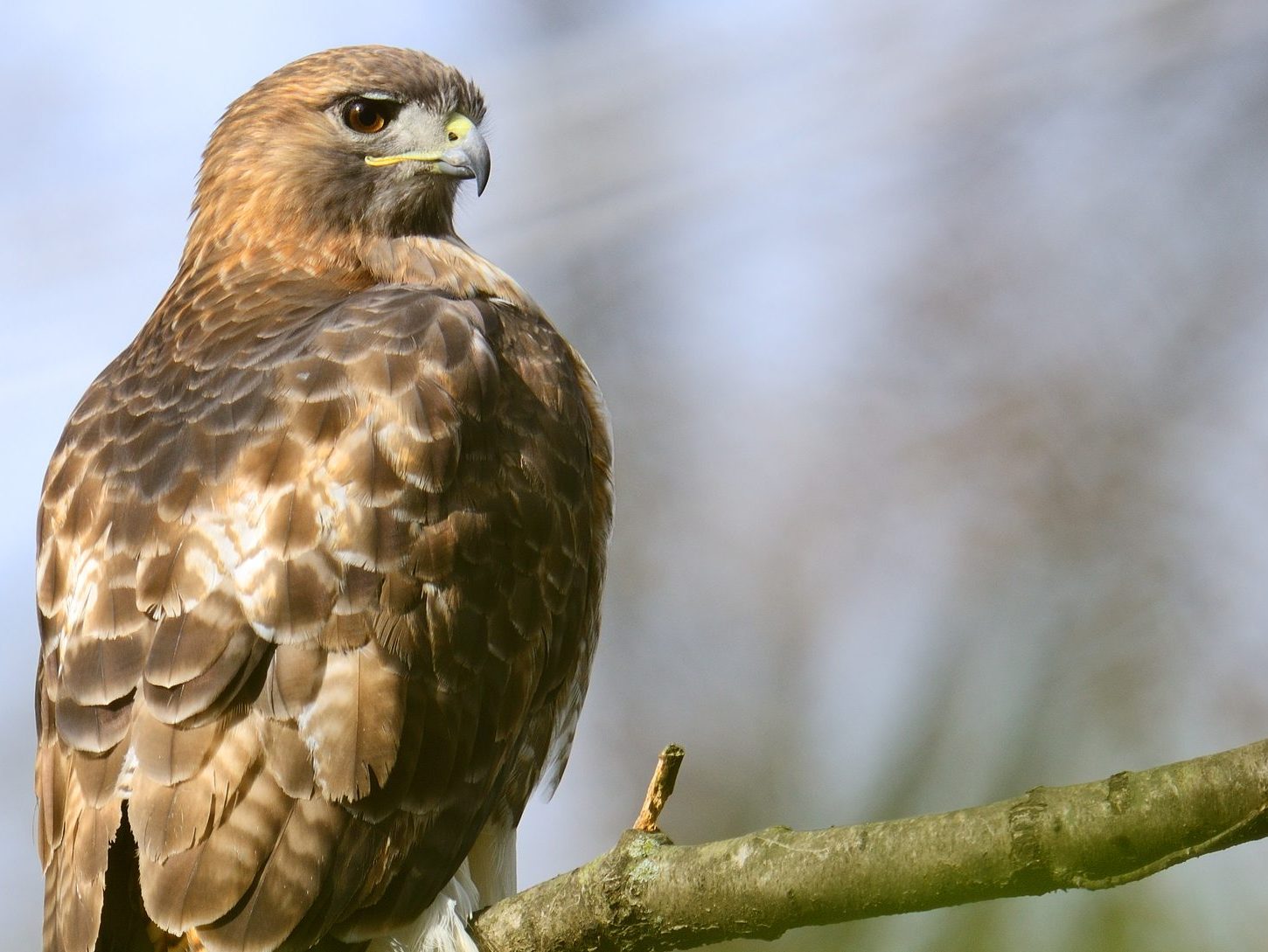
- Red-tailed Hawk (Buteo jamaicensis)
- Type of Bird: Raptor
- Native Range: North America and part of Central America
- At the Aviary: Resides Behind the Scenes
- Lifespan: 20-30 years
- Conservation Status: Least Concern
- Available for Naming: 1 male
- Naming Rights: $2,500
Quails
Quails are small ground birds, with short, broad wings, and are often well camouflaged. Their dappled plumage helps them blend in with their surroundings, usually in grassland areas. Many grouse species, like the Masked Bobwhite, are in sharp decline due to habitat loss.
The Masked Bobwhite (Colinus virginianus ridgwayi) is a distinct subspecies of the Northern Bobwhite. The range of this small ground-dwelling bird is restricted to the Sonoran Desert and extreme southern Arizona. Only about 200 Masked Bobwhite remain in the wild, but a program to help Masked Bobwhites breed in human care is working to repopulate Masked Bobwhites in their native range.
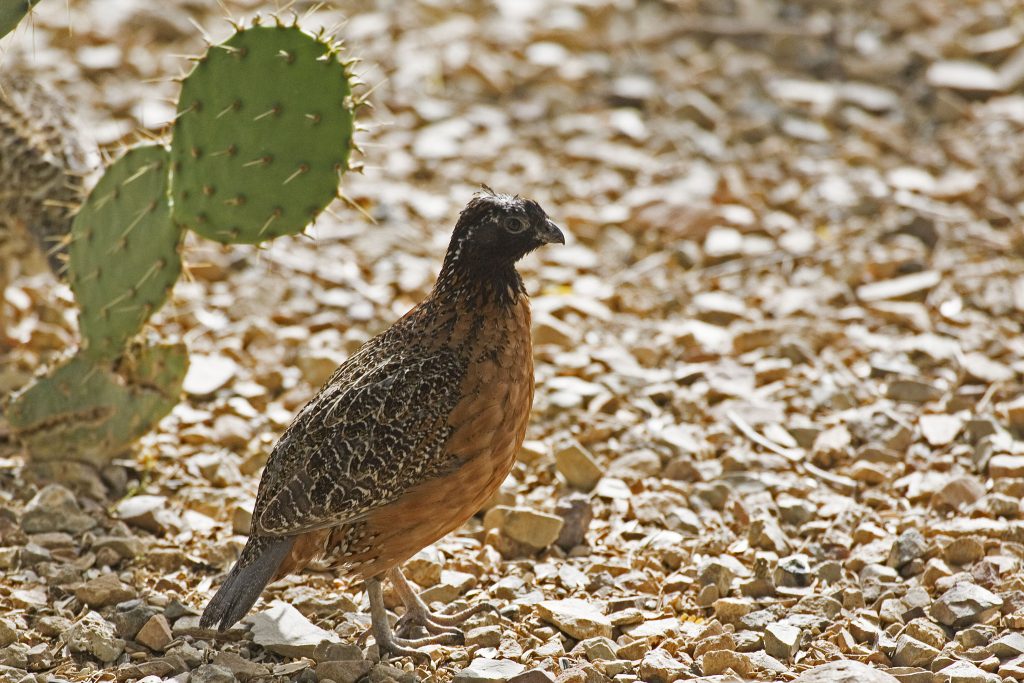
- Masked Bobwhite (Colinus virginianus ridgwayi)
- Type of Bird: Quail
- Native Range: Sonoran Desert and extreme southern Arizona
- At the Aviary: Resides in the Grasslands
- Lifespan: 10-15 years
- Conservation Status: Least Concern
- Available for Naming: 3 males
- Naming Rights: $2,500
To inquire about Name-A-Bird opportunities, please contact Ted Bartlett at [email protected] or 412-258-9433.
